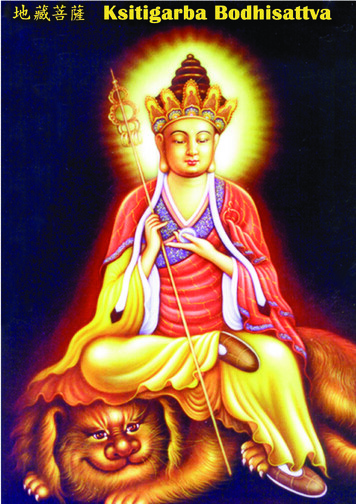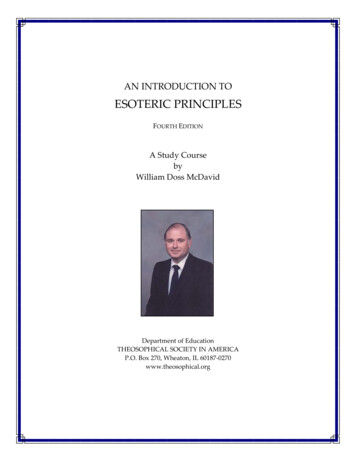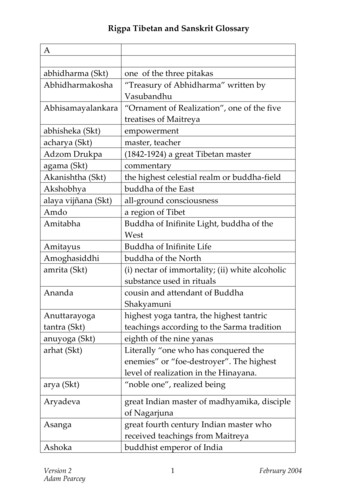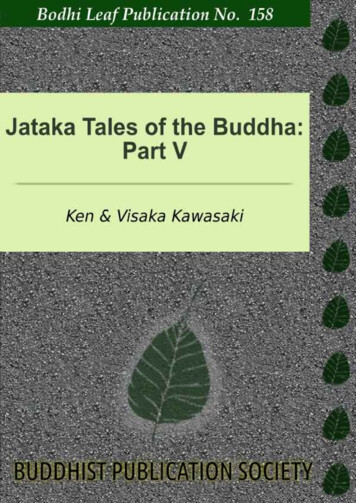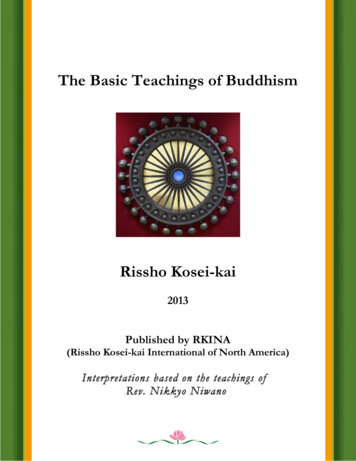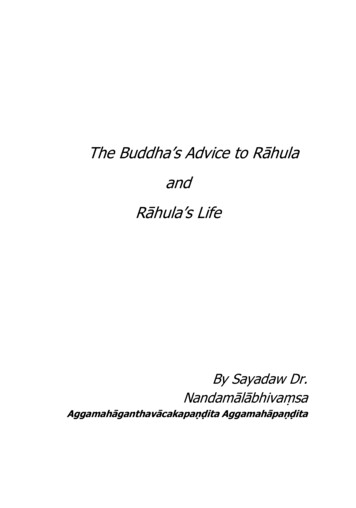
Transcription
The Buddha‘s Advice to RāhulaandRāhula‘s LifeBy Sayadaw �ḍita Aggamahāpaṇḍita
Sayadaw Dr. Nandamālābhivaṃsa
The Biography of Sayadaw Dr. NandamālābhivaṃsaSayādaw Dr. Nandamālābhivaṃsa, born in Myanmar (Burma)in 1940, was educated in Mandalay and with 16 years of agehe already passed Dhammācariya (Dhamma teacher) and themost difficult Abhivaṃsa examination. He also studied in SriLanka at the Kelaniya University in Colombo ( M.A.) and gothis Ph. D. in India.Because of his excellent knowledge of Buddhist scriptures andhis teaching experience, he was rewarded with many highdistinctions and titles such as Aggamahāganthavācakapaṇḍitaand Aggamahāpaṇḍita.Below is his profile: Rector of International Theravāda Buddhist MissionaryUniversity (ITBMU)Rector of Sītagū International Buddhist Academy(Sagaing Hill)Rector of International Institute of Abhidhamma(Yangon)Padhāna-Nāyaka of Mahāsubhodhārāma Institute(Sagaing)Padhāna-Nāyaka of Sadhammajotika SubhodhārāmaInstitute (Monywa)He is the chief abbot for the traditional, well-reputed studymonastery ―Mahāsubhodayon‖ (Mahāsubhodhārāma Institute)in Sagaing Hills. He is the of founder and leader ofDhammavijjālaya, Centre for Buddhist Studies (CBC) inSagaing, which is connected to Mahāsubhodayon Monasteryi
and serves foreigners for further studies and practice. He alsoopens a new Buddhist learning centre called DhammasahāyaSāsanā Centre in Pyin Oo Lwin (May Myo).He is rector of the International Theravāda BuddhistMissionary University, which offers a chance for foreignersand Myanmar people to study Buddhism from Diploma up toPh. D. level in English language.In Myanmar and abroad, since some years in Europe too, heis giving courses mainly on Abhidhamma for WesternVipassanā-teachers, students and meditators.The teaching method of Sayadaw Dr. Nandamālābhivaṃsa isvery individual, lively, practical and practicable with manyexamples and references from daily life, from the Suttas,Abhidhamma-books and commentaries. Sayādaw is teachingin English and with a lot of humour and loving-kindness(mettā).ii
PrefaceThis gift of Dhamma (Dhammadāna) is translation hivaṃsa on 23 November 2010.Aggācāra Dhamma Distribution Group translated the recordedDhamma talk. Sayalay Vīrañāṇī (an American nun living atChanmay Myaing Meditation Centre) has kindly edited thetranslation.With this translation, the translators would like to record theirgratitude to Sayadaw Dr. Nandamālā for his loving-kindnessand wisdom in sharing the Dhamma with us. Those who havelistened to his Dhamma talks have learned new Dhamma, theold Dhamma has become crystal-clear, and many doubts havebeen cleared away.We are also happy that he always explains the Dhamma fromthe viewpoint of Abhidhamma, and how to practically realizethe Dhamma through Vipassanā practice.This book is intended for people who like to know more aboutthe life of Venerable Rāhula. It is also for Vipassanāmeditators who want to know more about contemplation ofthe six sense bases. Finally, it is for all Dhamma-lovers, whoare simply seeking for the truth within themselves.May all rejoice in this gift of Dhamma (Dhammadāna)!Sādhu! Sādhu! Sādhu!iii
Note:The picture at front cover is photo of a main door of SītagūInternational Buddhist Academy while the picture at theback cover is the view of Sagaing river.The Sayadaw Dr. Nandamālā‘s photos were taken when hewas teaching students from Malaysia, German, Nertherlandetc. at Centre for Buddhist Studies (CBC), Sagaing inNovember 2012.The book is for free distribution only. You may copy andredistribute any texts from this book, provided that youabide by these two basic principles:1. You may not sell any texts copied or derived from thisbook.2. You may not alter the content of any texts copied orderived from this book. (You may, however,reformat them)This book is translated and published by:Aggācāra Dhamma Distribution Groupaggacara2013@gmail.comPublication date: February 2013iv
Table of ContentsThe Buddha‘s Advice to Rāhula and Rāhula‘s life . 1Fifteen vimuttiparipācanīyā. 6Internal Contemplation of Mental and Physical Phenomena . 14The Stages of Insight Knowledge . 19How the Venerable Rāhula Gained Enlightenment . 21End of the Life of the Venerable Rāhula . 31v
THE BUDDHA‘S ADVICE TO RĀHULA AND RĀHULA ‘S LIFEAs recorded in the Tipiṭaka, among the 84000 dhammas,there are about 40 discourses or suttas about VenerableRāhula.When Rāhula was seven years old, the Buddha gave him anadvice. It is recorded as the Discourse of Advice to Rāhula inMango Park (Ambalaṭṭhika Rāhulovāda Sutta i ). Again whenRāhula was eighteen, at a time when youngsters start to havefun and enjoy themselves the Buddha gave suitable advice tohim. This is recorded as the Greater Discourse of Advice toRāhula (Mahārāhulovāda Sutta ii ). These discourses (suttas)are numbers 61 and 62 in the Chapter on Monks(Bhikkhuvagga) in the second section of Middle LengthDiscourses (Majjhima Nikāya).At the age of twenty, Rāhula had become a monk. Before therainy retreat arrived, he practiced meditation and became anarahant. Today, I will explain what meditation was practicedat that time. This advice of the Buddha to Rāhula is namedas the Shorter Discourse of Advice to Rāhula (CūļarāhulovādaSuttaiii) and is recorded in the chapter of six sense bases inthe third section of Middle Length Discourses.There are 22 discourses collected as Rāhula-saṃyutta; and 2discourses related to Rāhula in Khandha-saṃyutta inConnected Discourses of the Buddha (Saṃyutta Nikāya); andthere are 2 discourses related to him in the NumericalDiscourses of the Buddha (Aṅguttara Nikāya). I will also referto Mahārāhulovāda Sutta and Cūļarāhulovāda Sutta. For the1
today Dhamma talk, I will extract the essence out of these 28discourses and teach all of you accordingly.As for Rāhulovāda Sutta, we can differentiate the Mahā r āhulovāda Sutta and the Cūļarāhulovāda Sutta. The former islonger, that‘s why it is called Mahā (―Greater‖). The latter oneis a little shorter, so it is called Cūļarāhulovāda Sutta.In the case of the names Mahā Panthaka and Cūļa Panthaka,these designate real persons; the former is the elder brotherwhile the latter is the younger brother. But there is no suchperson called ‗Cūļa Rāhula‘ or ‗Mahā Rāhula‘.When he was a novice (sāmaņera), Rāhula‘s preceptor wasthe Venerable Sāriputta. His Kammavācā recitation teacherwas the Venerable Moggallāna. Kammavācā is the compilationof the rules and the ritual regarding admission into thecommunity of monks (saṅgha).Nowadays in Myanmar, novice ordination follows theprocedure of Venerable Rāhula, who was the first novice inthe Buddha‘s dispensation. How Rāhula received monkordination is the same as today‘s monk ordination. When hereached 20 years old and became a monk (bhikkhu), hefrequentlypracticed Insight Meditation (Vipassanā).Sometimes, the Buddha would give him suitable advice.Even though he practiced hard in meditation and receivedsuitable advice, he could not gain enlightenment. Similarly,those with immature pāramī could not become enlightenedeven if they tried hard in their meditation practice. Only theBuddha knew the right time, when their pāramī and faculties2
(indriya) would be mature for enlightenment. The facultiesare faith (saddhā), concentration (samādhi), mindfulness(sati), effort (viriya) and wisdom (paññā).You have all seen the lotuses in the lotus lake. Even thoughthe lotus buds appear today, they will not bloom today. Theybloom when the time is right. When they have sufficientsunlight and are mature, they will bloom. So also, it isimportant for the pāramī to be mature.When someone cannot attain enlightenment in this life, oneof the causes may be immature pāramī. Another reason islack of strong faith. The next reason is a lack of strong effortto strive hard in meditation regardless of one‘s own life andbody. One must make the effort and be able to let go ofeverything. One can check oneself by comparing the time onespend practicing meditation and the time one spend notpracticing meditation. Which is more? Maybe one don‘t reallywish for enlightenment, and one pāramī is not yet mature.Look at a would-be traveler about to go on a long journey. Hehas not yet made a single step. So his destination is definitelyvery far away. If he makes a step, he will have 99 stepsremaining on a journey of 100 steps. If he makes 50 steps,there would be a remaining 50 steps to go. If he finishes 75steps, only 25 steps will be remaining.In the same way, when one practices meditation one mightnot reach arahatship straightaway. However, one shouldgradually move towards one‘s final destination, which isliberation. One just has to take one step after another.3
At the time [of the Cūļarāhulovāda Sutta], the VenerableRāhula had become a monk and the rainy retreat had not yetbegun. One day, he came to see the Buddha and requestedhim to teach a method of meditation. ―May the Buddha teacha brief meditation method. Then I will go to a secluded place,and with mind inclined only towards Nibbāna I will try myutmost to practice meditation.‖When we talk about meditation, we are not looking elsewherefor the dhammas, but looking for the ultimate truth within us.We should contemplate on our own mind and body. TheBuddha always encourages his disciples to seek for the truthwithin, not outside. Even though having given manydiscourses to various people, he placed primary importanceon the practice of Vipassanā.Every dawn and evening, the Buddha would survey the wholeuniverse, looking for sentient beings who would be able toattain higher dhammas or enlightenment. At dawn, by usinghis omniscience knowledge (sabbaññutañāņa), the Buddhasurveyed the world. Starting from his fragrant chamber(gandhakuṭi), he pervaded as far as the farthest end of abbaññutañāņajālaṃ pharitvā‖). The beings who could behelped to be enlightened appeared in the wisdom mind of theBuddha just as one sees images on television.At that time, even though someone might be staying nearby,if his pāramī were immature and not yet ready forenlightenment, his image would not appear in the mind of theBuddha. In the evening also, the Buddha surveyed theuniverse in the different directions, starting from farthest end4
of the universe and coming to the nearest place (themonastery where he stayed).One day as usual, just as one casts a net over the sea, theBuddha pervaded the universe with his omniscient power. Hesaw Rāhula, and was aware that in Rāhula‘s mentality, thevimuttiparipācanīyā, the dhamma for liberation and thefruit of arahantship (arahatta-phala) had matured.(―Paripakkato Rāhulassa vimuttaparipācanīya dhammā‖).Then, he taught a suitable meditation subject for him torealise the cessation of all the taints (āsavakkhaya) and toattain the fruit of arahantship (arahatta-phala). In the sameway, a meditation teacher nowadays gives suitable meditationinstructions to the meditators.5
FIFTEEN VIMUTTIPARIPĀCANĪYĀThere are 15 vimuttiparipācanīyā dhammas, factors that canlead one to enlightenment. These are mentioned inCūļarāhulovāda sutta and further explained in its commentary.We need to fully develop whichever factors we have in us,bringing them to perfection and maturity. In the case of nonexistent factors, we have to cultivate these and bring them togrowth. Paripācanīya means to cause things to be matured.Vimuttī means liberation from defilements (kilesa) or taints(āsava).In the commentary, these 15 dhammas are initially dividedinto two groups based on different inherent tendencies ofbeings.In the first group, the five faculties are mentioned first. Thesefive faculties are the faculty of faith (saddhindriya), thefaculty of effort (viriyindriya), the faculty of mindfulness(satindriya), the faculty of concentration (samādhindriya), andthe faculty of wisdom (paññindriya).Saddhā means faith or resolution and determination onsomething. On a basic level, the saddhā means belief inkamma and its result, and taking refuge in Triple Gem. Thehigher level of saddhā means to believe in impermanence(anicca), unsatisfactory or suffering (dukkha) and non-self(anattā) of all psychophysical phenomena.Whoever has practiced Vipassanā will know this. When henotes any material and mental phenomena, he sees themquickly arise and quickly pass away. He knows this throughhis personal experience. He can make decision for himself6
that all phenomena are impermanent (anicca), unsatisfactory(dukkha) and non-self (anattā). This kind of determination orresolution is saddhā, faith or resolution.The second faculty is viriya. It means energy, or making effort.There are two types of effort, one that is applied to thewholesome (kusala) and the other to the unwholesome(akusala). Altogether these are as follows: One makes effort to develop the wholesome states ofmind that exist already. One tries to bring them toperfection in practice until the attainment of path andfruition knowledge (magga-phala ñāņa).For non-existent wholesome states, one makes aneffort to cultivate and bring them to growth.One makes an effort to eradicate existingunwholesome states of mind.One makes an effort to prevent non-existentunwholesome states from developing.The third faculty is that of mindfulness; this means thedevelopment of mindfulness which is the same as the practicein the Discourse of the Foundation of Mindfulness(Satipaṭṭhāna Sutta). There are four foundations ofmindfulness. One makes effort to have continuous awarenessand observation on his material phenomena, all feelings, allstates of mind and mental objects (dhammas).The fourth is concentration (samādhi). With the faculty ofsamādhi, the mind is free from hindrances (nīvaraṇa) whichcan disturb the concentration (such as sensual enjoyment,kāmaguņa). This high level of concentration is to have7
absorption concentration (appanā samādhi) such as firstjhāna, second jhāna etc. It is very peaceful and blissful. If onecannot obtain it, what should one do? As long as one cankeep the mind on the meditation object like breathing etc. forfive minutes, ten minutes or thirty minutes, one hour andsoon on, one can obtain neighborhood or accessconcentration (upacāra samādhi) which is in the vicinity ofjhāna.By Vipassanā practice, one can also have momentaryconcentration (khaņika samādhi) which observes andconcentrates on the arising and passing of phenomena frommoment to moment.Whether it is absorption concentration, neighborhoodconcentration or momentary concentration, as long as onecan observe the object, can keep the mind on the object, andthe mind is not far away from the object, then one will haveconcentration (samādhi).The fifth faculty, wisdom (paññā), does not refer to theworldly knowledge we can get from our surroundings. Thiswisdom actually means understanding the arising and passingaway of physical and mental phenomena within oneself.The indriya actually means ruling faculty or that which has thepower to govern its own domain or sphere. The faculty offaith (saddhindriya) means to have ruling power over thedomain of resolution or domain of determination, whileviriyindriya means having ruling control over effort. Satindriyameans to exercise control over those things that are to benoted and remembered. Samādhindriya has the power over8
the domain of stability and calm. Paññindriya has the powerover the things to be known. In short, the faculty (indriya)have governing power over their respective spheres anddomains.To make these five faculties mature, what do we need? Thesefive faculties should be multiplied by three ways (to avoid, toassociate, to develop) to give a total of 15 vimuttiparipācanīyādhammas. These fifteen factors will be explained here.To develop fully the faculty of faith (saddhindriya), we shoulddo as follows:1. Avoid those without faith.2. Associate and approach those with faith.3. Read, listen and contemplate on those discourses thatcan inspire confidence and raise faith.So if we associate with those without faith, our own faith willbe reduced and be ruined after some time. Some peoplemight think it does not matter even if one associate withthose people. But just as a Burmese proverb says: ―If youassociate with hunters, you will be a hunter; if you associatewith fishermen, you will become a fisherman‖. Anotherexample is leaves wrapping dead fish; the leaves will havefoul smell. But leaves wrapping jasmine flowers etc. will havea fragrant smell. The smell from the fish or the flowerspervades the leaves as well.Normally, people might not think about the influence ofpeople around them. We should consider this as the conditionof strong decisive support (upanissaya paccayo), which is one9
of the conditions in the 24 paṭṭhāna. When our associates arepeople without faith, and this is acting as strong decisivesupport, we will follow their behavior and thoughts. Soon, thegood faith within ourselves will be disappeared.On the other hand, if we associate with those with faith, andapproach them frequently, then our faith will increase. Weshould also contemplate discourses that can inspireconfidence in us, so the mind will be serene and pleased. Ourfaith will also be increased.To develop fully the faculty of effort (viriyindriya), we should1. Avoid lazy people.2. Associate and approach people with effort.3. Develop right exertion (sammappadhāna).To develop fully the faculty of mindfulness (satindriya), weshould1. Avoid those people who are without mindfulness.2. Associate and approach people who have mindfulness.3. �hāna).To develop fully the faculty of concentration (samādhindriya),we should1. Avoid those people who are without concentration.2. Associate and approach people who have concentration.3. Develop the dhammas that lead to concentration.10
To develop fully the faculty of wisdom (paññindriya), weshould1. Avoid unwise people.2. Associate and approach wise people.3. Contemplate on dhamma (like aggregates, bases,elements, noble truths, dependent origination etc.) anddevelop it deeply and respectfully.Sometimes, when listening to Dhamma, people listencarelessly and without paying attention. If one does not listenrespectfully and with serious attention, one will not get toknow the profound Dhamma. It is easy to listen to stories orvain talks. There is no need to make extra effort to remembersuch things. When there are jokes, people laugh; they canremember easily.When I was young, I heard people say that they went to aDhamma talk because it had jokes to be laughed at, andbecause staying at home was very boring. What a sad thing!Those people who came to listen Dhamma talk because theywanted to laugh at the jokes have a completely wrongattitude. If one loves jokes, one should go to shows offamous comedians or go to a movie. Actually, people shouldhave the right attitude that they must go to listen to Dhammatalks in order to acquire Dhamma knowledge, to gainknowledge and wisdom.So by multiplying these five faculties with the three wayspreviously mentioned: to avoid, to associate, and to develop,then we get fifteen vimuttiparipācanīyā dhammas.11
The commentary of this Cūļarāhulovāda Sutta also points outanother set of 15 vimuttiparipācanīyā dhammas.―Aparepi pannarasa dhammā vimuttiparipācanīyā —saddhādīni pañcimāni indriyāni, aniccasaññā, atādayopañcadhammāti. ―ivThe first five refers to five faculties like faith etcetera and aresame as mentioned above. The next five are:6. Aniccasaññā (the perception of the impermanence of allphenomena)7. Dukkhasaññā (the perception of the suffering aspect of allphenomena)8. Anattasaññā (the perception of the non-self nature of allphenomena)9. Pahānasaññā (the perception of things to be abandoned)10. Virāgasaññā (the perception of freedom from lust)The remaining five (11 to 15) are the five dhammas theBuddha preached to Elder Meghiya.11. Associate with kalyāṇamitta (a good friend).If you want to have good business, you should associate witha suitable friend with good business. If you want to knowDhamma and attain enlightenment, you should befriend andapproach those who know and are interested in the Dhamma.The term ―good friend‖ can also refer to any Dhamma teacher12
who can share the Dhamma properly, and who can teach youthe meditation method.12. Make effort in meditationEven if you have good friends, if you don‘t make effort inmeditation, you cannot achieve any higher dhamma.13. Ten types of suitable speechIn brief, speak sweetly with words free from greed, hatredand delusion. It also includes speech concerning Dhamma andmeditation, or speech that leads to reduction of defilements.14. Mindfulness (sati) means having awareness on themeditation object.15. Wisdom (paññā) means knowing the arising and passingaway of all phenomena.The statedfifteen dhammasare the second setofvimuttiparipācanīya.These fifteen dhammas that could lead to liberation(vimuttiparipācanīya) were matured in Venerable Rāhula.13
INTERNAL CONTEMPLATION OF MENTAL AND PHYSICAL PHENOMENAWhat is the meditation taught by the Buddha to the VenerableRāhula so that he could gain arahatship and final liberation? Itis the contemplation of phenomena within oneself.What are these? When we look at ourselves, we find out themain things are our six sense doors: eye, ear, nose, tongue,body, mind. Also the corresponding objects to these sensedoors: visible object, sound, smell, taste, touch, mentalobjects.Everyone has these mental and physical phenomena (nāmarūpa). When there is contact of the eye with visible object,eye-consciousness arises. When the eye-consciousness arises,the contact (phassa) which connects with the eyeconsciousness and the visible object arises. When contactarises, feeling (vedanā) also arises. Perception (saññā),mental formation (saṅkhāra) and consciousness (viññāņa )also arise together with feeling.In doctrine of dependent origination (paṭiccasamuppāda),these six sense doors are called as six sense bases(saļayātana). Because of six sense bases, contact arises(―saļayātana paccayā phasso‖). The contact comes after thesix sense bases. Then, because of contact, feeling arises(―phassapaccayā vedanā‖). Next, because of feeling, cravingarises(―vedanāpaccayātaņhā‖). However, in theCūļarāhulovāda sutta, it is said that contact comes togetherwith eye consciousness.There are 22 discourses (sutta) in Rāhula-saṃyutta in theSaṃyutta Pāļi. Among those discourses, the eye, visible object14
to be seen, and eye consciousness (which arises due to thecontact of visible object with the eye) are mentioned. Withthe combination of these three, together there will be contact(phassa), feeling (vedanā), perception (saññā), volition(cetanā) and craving (taņhā).In other discourses, the meditation methods and phenomenamentioned by the Buddha are not the same. For example, inMahārāhulovāda Sutta, which was delivered when Rāhula waseighteen years old, the Buddha taught contemplation on theFour Great Elements (mahā bhūta), as well as othercontemplations such as loving-kindness (mettā), compassion(karuņā), sympathetic joy (muditā), equanimity (upekkhā),the perception of loathsomeness (asubhasaññā) andperception of impermanence (aniccasaññā).Sometimes, the Buddha preached the six elements: earth(paṭhavī), water (āpo), fire (tejo), wind (vāyo), light (āloka)and consciousness (viññāņa). Sometimes, the Buddha alsopreached five aggregates in detail. They are 1) The aggregateof matter (rūpakkhandha); 2) The aggregate of feeling(vedanākkhandha); 3) The aggregate of perception(saññākkhandha); 4) The aggregate of mental-formation(saṅkhārakkhandha);5) The aggregate of consciousness(viññāṇakkhandha)However, in the Cūļarāhulovāda Sutta that we are discussingtoday, the Buddha mentioned 8 phenomena with regard tothe eye door: eye (cakkhu), visible object (rūpa), eyeconsciousness (cakkhu-viññāņa), contact (phassa), feeling(vedanā), perception (saññā), mental formations (saṅkhāra),and consciousness (viññāņa).15
The same can be said for the ear door: ear, sound, earconsciousness (which occurs due to combination of ear andsound), the contact that unites the ear and sound, the feelingthat occurs due to contact; and the perception, mentalformations and consciousness that come together withcontact.For the nose door, there are nose, smell, nose consciousness,the contact that unites the nose and smell, the feeling thatoccurs due to the contact. Due to pleasant smell, there will bepleasant feeling. Due to unpleasant smell, there will beunpleasant feeling. There is also the perception that notes thesmell, and mental formations—including volition (cetanā)which is the leader. The consciousness that is only pureawareness of the smell also arises.In short, there are 8 phenomena respectively with regard tosix sense doors: eye, ear, nose, tongue, body and mind. Oneshould be aware of these phenomena in Vipassanā practicebecause the contemplation on them can let one becomearahant. These phenomena occur in us every time and shouldbe observed. As such, after listening to this CūļarāhulovādaSutta, Rāhula became an arahant.I have explained these factors earlier so that you may findsuch phenomena in yourselves. All the phenomena have theirown characteristics. For example, there is the naturalcharacteristic of the eye. When the visible object strikes theeye, it also has its own natural characteristic.To know and practice Vipassanā accurately, first we shouldlook for the object to be observed. One should observe the16
natural characteristic (sabhāva-lakkhaņā) of these objects.Sabhāva-lakkhaņā means that the object has its own naturaland distinct characteristic which is not the same as that ofother objects.When we look at different persons, we start to note thedistinct parts of body and facial features like the shape ofhair, the clothes they wear, their height, the manner of theirwalking and so on. By noting these characteristics anddetails, we can remember and recognize who they are. Evenif someone is coming from afar, we can recognize who he is.When his body shape changes, our previous perception of himdoes not match the current perception, and we may becomeconfused.So also, the four great elements in the body have their ownindividual characteristic which has nothing in common withthe others. The earth element has the characteristics ofhardness and softness, while the water element has fluidityand cohesion. The heat element has the characteristics ofheat and cold. The wind element has supporting and motionas its characteristics. These natural characteristics are calledsabhāva-lakkhaņā in Pāļi.The Vipassanā practice is the observation of these naturalcharacteristic. If one cannot find it, one must make effort todiscover it. When one is sitting on a cushion, one will discoverthat where the buttocks are touching the cushion has thenature of hardness. Sometimes, there is a feeling of softnessat this touching point. This hardness and softness are thecharacteristic of the earth element.17
Sometimes, there is heat or cold in the body. Sometimes,sweat flows down, and sometimes there is motion andshaking in the body. These are the natural characteristics offire, water and wind. At the time of these events, don‘t thinkof impermanence (anicca), suffering (dukkha) or non-self(anatta). You should just be aware of the naturalcharacteristics of the four great elements.18
THE STAGES OF INSIGHT KNOWLEDGEWhen one is really able to observe all these naturalcharacteristics, then the general characteristic (sāmaññālakkhaņa) will emerge. The general characteristic means theimpermanent (anicca), unsatisfactory or suffering (dukkha)and non-self (anattā) characteristics of all phenomena.How can one observe impermanence? When one sees thearising and passing away of mental and physical phenomena,one understands that they are all impermanent. With theunderstanding of impermanence, one understands thesephenomena are all unsatisfactory and suffering. When oneunderstands unsatisfactoriness, one also understands thatthere is no self, I, or any controller existing at all. So one willunderstand non-self (anattā). By starting with the observationof the natural characteristics (sabhāva-lakkhaņa), then insightknowledge (Vipassanā ñāņa) increases gradually.Then, when one sees that all arising phenomena will soonpass away, one will gain the knowledge of arising and passingaway (udayabbaya-ñāņa). On seeing this arising and passingaway again and again, one‘s mindfulness, concentration andinsight knowledge gain strength. Then one will not see thearising of phenomena but only more clearly aware thedissolution and passing away of these phenomena. One hasattained the knowledge of dissolution (bhaṅga-ñāņa).One may feel fearful when seeing that things keep dissolving,so one will gain knowledge of fearfulness (bhaya-ñāņa).Earlier, one may think ‗this I is the one who sees thephenomena‘ but at this time one will know that there is no ‗I‘at all. Now, one is clearly aware of the danger and faulty19
nature of all phenomena. One then gains the knowledge ofthings as dangerous (ādīnava-ñāņa). Later one feelsdisenchanted from one‘s own physical and mentalphenomena. One will be no longer attached to them asbefore, and thus reaches the knowledge of disenchantment(nibbidā ñāņa).Then, one does not want to dwell with these phenomenaanymore and desires to escape from them. One will gain theknowledge of desire for deliverance (muñcitukamyatā ñāņa).If one wishes to escape from these phenomena, one needs toreflect the phenomena. This is the insight k
and wisdom in sharing the Dhamma with us. Those who have listened to his Dhamma talks have learned new Dhamma, the old Dhamma has become crystal-clear, and many doubts have been cleared away. We are also happy that he always explains the Dhamma from the viewpoint of Abhidhamma, and how to practically realiz
